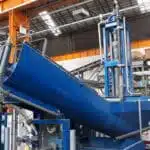Contact us
Indirect Classification
Indirect classification makes use of the different behaviour of particles depending on their grain size or mass, when they are positioned in an airstream (pneumatic classification) or in a liquid flux (hydraulic classification).
Pneumatic classification consists of carrying out a particle sized cut on a powdered and dry material suspended in a gas set in motion (generally the air) so as to obtain two distinct fractions – fines and coarse-grained particles. The separation principle is based on the effective (and not real) size of the particles by difference in speed and fall in a gas. This type of classification is carried out on particle sizes generally ranging between 1 and 100 µm.
The CTP has air separation equipment functioning at laboratory scale and at pilot scale.
| Equipments | Type | Theoretical cut | Capacity max (1) |
|---|---|---|---|
| Pilot dynamic separator |
 |
2 à 25 µm | 0,6 to 5 |
| Laboratory dynamic separator |
 |
15 µm | 5 to 15 |
| Pilot static separator | 63 µm | 0,6 to 10 |
The CTP is also equipped with an eddy current separator for the separation of non-ferrous metals (aluminium, copper, zinc) primarily for recycling processes. A rotary field, consisting of magnets with alternate polarities, can be rotated to cause magnetic fields in the conductive particles (mainly metal) facing the magnetic field of the magnet, which provokes the ejection of the conductive particles. When the rotary field is not rotating, the separator operates as a standard magnetic separator.
Hydraulic classification consists of separating the solid particles suspended in a liquid (the whole forming a pulp) into two distinct particle sizes – the fines (overflow) and the coarse-grained (underflow). The separation principle is based on the effective (and not real) size of the particles by difference in speed of sedimentation in a liquid. This type of classification is carried out on particle sizes generally ranging between 15 and 800 µm.
There are two main types of hydraulic classification equipment: gravitational classifiers or sedimentation classifiers (settling tank, screw classifiers, etc.), and centrifugal classifiers such as cyclone classifiers and centrifuges.
The CTP has hydraulic classification equipment functioning at laboratory scale and at pilot scale.
| Equipment | Type | Theoretical cut | Capacity (m³/h) |
|---|---|---|---|
| Hydrocyclone test benches |
 |
2 to 25 µm | 0,6 to 5 |
| Hydrocyclone skids | 15 µm | 5 to 15 | |
| Spiral classifier |
 |
63 µm | 0,6 to 10 |
All
Our expertises